4 Planning principles for more functional and environmentally friendly urban structures
The development pattern, centre structure, transportation system and green structures combine to make up the physical structure of cities and towns. These structures are changing gradually as a result of different development projects of varying size. In order to ensure development directed towards more functional and environmentally friendly urban organisation, the Government presents here key planning principles for the development of our cities and towns. Municipalities and counties are in charge of implementing these principles via their responsibility for land-use planning locally and regionally. National authorities also play important roles in many cities and towns. The Government therefore wants to stress the need for national authorities to follow up these principles as well.
4.1 Interplay and work distribution between cities and towns
Cities and towns are gravity centres for larger areas of surrounding countryside. The bulk of industry, services and other business activities localise in urban areas. Smaller cities and towns should particularly accommodate business development, both in order to function as dynamic and vital hubs for their surroundings, as well as to ease the pressures on the bigger cities.
It is important to clarify the opportunities and functions of different cities and towns within a city network defined by regional planning. Within the boundaries of actual employment, housing and service regions, regional centres with specific regional functions should be defined. Co-operation among the municipalities is important to encourage the development of the regions and to avoid conflicts between different centres. Changes in the transportation system should harmonise with land-use planning locally and regionally. The transportation system must also be viewed in a national perspective. Adequate co-ordination between the different transportation modes should be ensured for the transport nodes and corridors, as well as satisfactory connections between the national system, the local and the international transportation networks.
Textbox 4.1 Østlandssamarbeidet – Regional co-operation in Eastern Norway
Østlandssamarbeidet, a co-operative forum consisting of eight participating counties, has carried out analyses showing that the development of a multi-centre structure may have favourable effects on the environment, business development, education, services and economic development. First and foremost, the bigger cities or the clusters of cities in the outer peripheries of the commuting area of Oslo have the opportunity to supplement and partially compete with the capital region of Norway: the string of cities along the Vestfold coast, the regions of Nedre Glomma and Grenland, and the Mjøsbyen area consisting of three smaller cities.
To develop a multi-core structure in Eastern Norway efficient transport connections between the four city clusters and the capital is required. Preferably, the railway should be developed first to take care of the main volume of passenger traffic . Further, well-functioning transportation connections between the regions' different parts and their centres are required, in order to secure an efficient interplay, as well as a positively develop each cities' specific qualities.
The idea of multi-core structures to create improved regional balance is not Norwegian. The «European Spatial Development Perspective» provided inspiration, where the European Union recommends three objectives for regional spatial planning:
A balanced and multi-core structure of cities
Equal access to infrastructure and human capital
Careful management and development of natural and cultural heritage
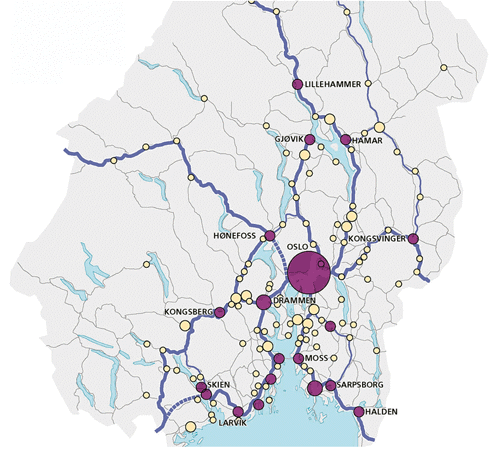
Figure 4.1 Cities and towns connected to the railway system in eastern Norway.
Source Norges Statsbaner
Textbox 4.2 European Conference of Ministers responsible for Regional Planning (CEMAT) – Guiding principles for Sustainable Spatial Development of the European Continent
The guiding principles were adopted at the 12th Session of the European Conference of Ministers on 7-8 September 2000. Norway endorsed the guiding principles, like to other members of the European Council.
The principles express a programme for greater cohesion among the regions of Europe. The relevant principles, in relation to sustainable development in cities, are towns are referred below:
Manage the urban sprawl, that is to limit tendency of growing suburban by increased access to non-developed areas, utilise the potential of the deteriorated areas and un-build plots, develop and enhance development in central neighbourhoods, locate new development in the vicinity of public transport nodes and railway stations, enhance development in inner city-areas, reinforce housing conditions and improve quality of life
Innovation of neglected neighbourhoods and mix businesses, services and social groups within the city-structure, particular attention should be drawn to selected neighbourhoods experiencing social problems
Manage carefully the cities’ eco-system, particularly regarding public places, green structure, water, energy, waste and noise
Develop efficient and environmentally public transport, which can contribute to sustainable mobility
Establish inter-municipal and inter-city bodies, in order to co-ordinate planning and implementation of measures which cross administrative borders
Conserve and refine important cultural heritages, and develop city networks.
4.2 Concentrated city-structures and environmentally friendly transport
4.2.1 Long-term development strategies and co-ordinated land-use and transportation planning is required
The Government wants to develop cities and towns with efficient and environmentally friendly transport, which contribute to health-enhancing transportation choices, consumption patterns and lifestyles. This requires a denser urban organisation. Concentrated development of cities and towns will reduce the growth in transportation needs for both businesses and the populace, and it will improve accessibility for people that do not have a private car. A concentrated city-structure also contributes to reducing the strain on valuable forests, outdoor recreation areas, farmland, cultural environments and biological diversity around cities.
Accessibility and mobility must be ensured, but cities and towns should be developed in ways that provide the population with choices for meeting their transportation needs. This has to be done, first and foremost, by channelling new growth and development in ways that limit urban sprawl. The development pattern should be co-ordinated with the major network of public transport, including lines for buses, metro, trams and ferries, instead of more random developments along the road system, since this often require the use of private car. In a long-term perspective, it is more economical for society to develop a competitive public transport system, but this requires that urban development is co-ordinated with the public transport system. The public transportation system should be developed into a continuous network that connects the city-centre, sub-centres, towns, and different nodes in neighbourhood municipalities.
Concentrated urban structures must be developed through long-term restructuring towards set objectives. Emphasis should be given to developing the main city centre, the various sub-centres of the city, and the towns around the city. Development should primarily occur through new and improved uses of poorly utilised land and existing structures within the building zone, rather than development of new land and further urban sprawl. Opportunities to fit new dwellings and businesses into denser, historical parts of the cities should be attempted systematically. Clearly defined long-term boundaries between built-up areas and farmland, nature and outdoor recreation areas should be established. Valuable and productive farmland in particular should be protected against development and fragmentation.
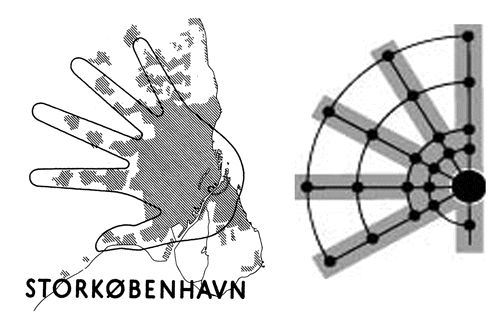
Figure 4.2 The «Finger Plan» for Copenhagen was introduced in 1948, and it has since formed an important basis for all further development. Train and bus lines service «the fingers» both radial and concentrical, and the inhabitants are assured short distances to green structures between the «fingers».
Source The municipality of Copenhagen
Textbox 4.3 County Plan for long-term city development in the Jæren region
The Jæren region has around 250,000 inhabitants today, and its population is expected to grow by over 100,000 over the next 40 years. The towns are about to converge into a more or less continuous city agglomeration consisting of ten municipalities. In order to handle the growth in the best possible manner, a comprehensive county plan for long-term city development has been drawn up. The rationale for this is both to maximize the utilisation of already built-up areas and to decide on a main direction for future development.
The plan was result of a close co-operation between municipal, county and national authorities – a partnership that will continue through the implementation phase. The county plan gives guidelines for planning at the municipal level, as well as national investments in the region. It is an important political instrument to manage the development of the region.
An efficient spatial utilisation and reduced land-use per person will be the most important contributions towards the protection of non-renewable resources. A dense development is also necessary to secure efficient public transportation. Growth is therefore primarily planned within the existing city-structure or in direct connection to developed areas. Potential expansions should take place along public transport corridors. Important elements of the plan are development areas for housing and businesses, regional centre structure and green structure, and long-term boundaries for protecting highly valuable farmland in the region.
An impact assessment analysis has been carried out which shows that the planned city development along public transportation axes, with densities particularly high in nodes and centres, will reduce expected transportation growth from 65 % to 20-45 % over the next 40 years.
4.2.2 Public transport must be strengthened
A centralised transportation policy for city regions is essential to limit transportation growth. A lot has been done to establish a useful system of main roads to serve through traffic and operations that require road transport. The Government believes that it is crucial to improve urban public transport in city agglomerations when environmental considerations and congestion demand. Transfer of some of the passenger traffic from the private car to public transportation methods is needed to reduce environmental, health and land-use problems in urban agglomerations. National efforts must be combined with local measures that can affect the choise of transportation mode and the demand for transport. Total transport levels must be sustainable.
The Government will contribute to increasing the market share of public transport in city regions. Co-ordinated land-use and transportation planning is fundamental to accommodate such a development in the long term.
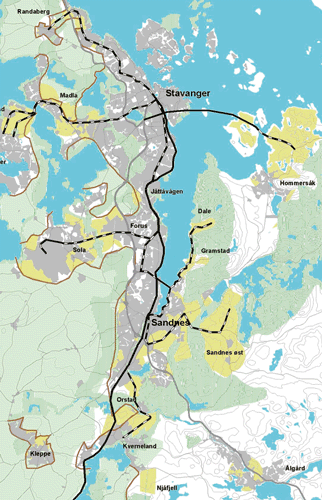
Figure 4.3 Long-term city development in the Jæren region. The map shows how existing and new development pattern (grey and yellow) support the public transport system by rail and bus. The majority of the future growth shall take place within the existing building zone, for instance at Jåttåvågen. The map also shows boundaries towards agriculture (light green) and green structure areas (darker green).
Source Rogaland fylkeskommune and Asplan Viak
Traffic congestion problems in cities are primarily associated with the limited capacity of the road system, but railways are also plagued by capacity problems during peak hours. To win an increased share of the public, the public transport system must offer a competitive product. To be an attractive alternative to the private car, public transport must provide a frequent and comprehensive service. Public transport also needs to be prioritised in urban areas. For a more detailed discussion of these issues, the White Paper on Public Transport is recommended.
4.2.3 Improved planning for cycling and walking
In order to improve environmental quality, health and quality of life in cities and towns, more emphasis should be given to developing attractive, efficient and safe infrastructure for people walking and biking. A higher share of non-motorised transport for short trips will also help make the road system and public transport system more efficient.
A continuous network of cycle lanes efficiently connecting sub-centres, downtown and public transport nodes, should be established. Attractive and ample opportunities for cycling in residential areas should also be a priority. This would include quiet residential streets, trails and shortcuts and act as a supplement to the main network of cycle lanes. In downtown areas, where space is limited, bicyclists should be given room and priority in the road, or be mixed with other low-speed traffic. Sufficient parking possibilities for bicycles should be ensured at public transport stations and other nodes of activity.
Children and adolescents should be able to travel safely in their neighbourhoods. Walking and biking is important for the childrens’ physical development. The need to transport children by car would also decrease if they, to a greater extent, could walk or bike to their activities.
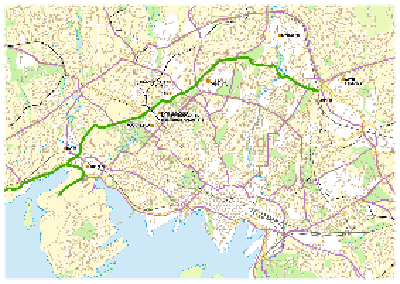
Figure 4.4 Proposed green, bicycle corridor through the city of Oslo.
Source The municipality of Oslo, InBy
4.2.4 Public transport nodes are important areas for city development
Poorly utilised land and transformation areas in downtown areas, sub-centres and around public transport nodes are important areas for development in the years to come. Within walking distance of public transport nodes development may be prioritised at the cost of valuable farmland, given efficient utilisation and the safeguarding of cultural heritage and other local qualities. The public transport nodes should appear as an integrated part of the city and town appearance. They must offer travellers efficient transport, transfers, comfort and quality during their stay. Nodes in the peripheral zones of the cities should particularly accommodate transfer between private and public transport. Adequate parking capacity for cars and bicycles should be ensured at these locations. Public transport nodes in central parts of cities and towns should in principle have less parking capacity than other areas, and the required capacity should be localised without conflicting with public spaces. Municipalities are responsible for parking capacity, and they now have the opportunity to decide on maximum norms rather than minimum norms.
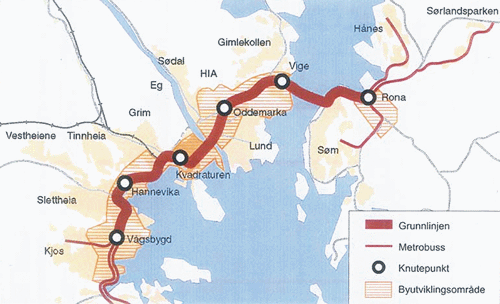
Figure 4.5 The public transportation axis («BusMetro») in Kristiansand makes it possible to obtain a high frequency and attractive public transportation system. Further city development is primarily planned to take place around the transportation nodes along this axis. Waterborne heat based on leftover energy from industry is transported along the same axis.
Source The municipality of Kristiansand
4.2.5 Concentrated housing developments
Growing cities and towns face significant challenges related to providing sufficient housing. Greater land allocation for housing purposes and higher degrees of utilisation are necessary to ease the pressures on housing markets. To limit urban sprawl, land for new development should primarily be found within the building zone. This requires municipalities within common housing develop housing strategies together. Towns around the cities should be developed in order to reduce the need for new dwellings in the cities. This may: ease the pressure on cities, and have a positive impact on land and housing costs. It may also increase the opportunities to protect green structures and woodlands near city boundaries, and strengthen the market for regional public transport. Land-use statistics show a considerable potential for infill and transformation in urban cities and towns without threatening valuable green structures. Industry structure and deveopment patterns for businesses are changing. This creates opportunities to place dwellings in areas previously intended for business activity. Industry and business restructuring has also resulted in poor utilisation of existing buildings. This also presents opportunities for transformation into housing.
Undeveloped land should not be considered for development before the potential within the existing building zone is examined. When developing large areas outside the building zone, special concern should be given location, size, utilisation and rate of development, in order to achieve efficient public transportation.
4.2.6 Strategic land-use planning gives efficient business traffic
Strategic localisation of new businesses and co-ordinated land-use and transportation planning may contribute to reduce businesses' needs for transport by concentrating the flow of goods. By placing businesses that serve large customer volume near nodes of public transport, accessibility and environmentally friendly transport is strengthened, while car dependency is reduced. Businesses generating large volumes of traffic should be localised near stations and nodes for public transport. This includes offices, private and public services, shopping malls, hospitals and educational institutions. New enterprises should suit and strengthen the form and character of the place in which they are integrated. Several counties have, in company with the municipalities, developed guidelines for centre structure and localisation of commercial activities. Businesses that generate substantial heavy transport should be localised close to main roads, railways and harbours. This will make business transport more efficient and reduce the negative impacts on people and the environment. Well-organised nodes for reloading and transfer of goods should be developed in order to secure efficient transport chains.
More freight transportation on railways and waterways
Freight transport is on the rise, and has since 1995 increased at a higher rate than the economic growth. Also, the share of freight transport on roads is increasing. This contributes to delays and unreliable transport of goods, which represents substantial costs for businesses. Efficient freight transport, competitive businesses and environmentally friendly development necessitate more freight transport by rail and water. Planning of infrastructure for freight transport should therefore be focused on solutions that meet the goal of transferring goods that go by roads today to railways and waterways.
The costs and conflicts of expanding transport capacity in cities are often substantial. By shifting some of the freight transport from roads to railways and waterways, demand for road capacity in cities will decrease. However, almost every short transport, and also the beginning and end of most transport, takes place on roads. The need to maximize existing infrastructure is therefore ever more crucial. Planning of urban transport should emphasise the need to transfer as many passengers as possible from private cars to public transport and cycling. In this way, road capacity is made available for business and goods transport. Forecasts indicate that freight transport via ports will increase. This may cause needs to expand or relocate port functions – decisions with considerable importance for city development and transport patterns. Densification and relocation of port activity may sometimes release land for city development, with a potentially higher economic utilisation of land. On the other side, such actions also may lead to a less efficient transportation system with congestion problems and negative impacts on safety and environment. All these kinds of considerations must be taken into account when assessing new areas for harbour activity. It is essential to co-ordinate the planning of harbour activity with local and regional planning of land-use and transportation.
Textbox 4.4 Comprehensive urban development of a public transportation node
In Bekkestua, in the suburban municipality of Bærum, a comprehensive development project is completed consisting of a new road system, an improved public transportation node, new dwellings and business activities, as well as a new main street and urban spaces. Buildings and urban spaces of high quality and a distinct character are developed here.
Bekkestua has become an important node for road, metro and bus transport in eastern Bærum. Public transport is strengthened. Traffic volume over Bekkestua metro-station doubled between 1991 and 1999, while traffic in general increased by 35 % in this period. The municipal plan of 1990 aimed at developing Bekkestua into a local centre with a large share of housing and development potential of 300-400 new dwellings. Subsequent plans estimated an additional potential of 17,000 square meters of business development. A local plan for land-use established the scope and limits for development of the centre: a new main street, car traffic subordi nated to pedestrians, a new main road system partially outside and partially beneath the centre, and joint localisation of the metro station and bus terminal. A separate plan was developed for outdoor spaces and street-use, and specified guidelines for buildings, including decisions on colours and materials. In the construction-plan, specific criteria for each of the different sectors were decided.
An important success criterion was securing funding before implementing the different plans. Political resolutions required that private property owners also contributed. The costs were split like this: public road authorities financed a new national road in a tunnel beneath the centre, a county road around the centre, one part of the main local street through the centre, and a new bus terminal for NOK 170 million. The municipality of Bærum contributed 47 million to these projects. Property owners supplied 6.5 million to complete the joint projects according to development contracts.
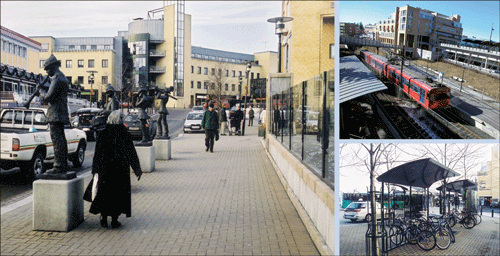
Figure 4.6 Bekkestua with new dwellings and businesses around the public transportation node, including the metro station and a new bus terminal.
Photo: Johan-Ditlef Martens and Svein Magne Fredriksen
City-regions facing questions of harbour expansions or re-localisation, should investigate alternative use of the port areas, as well as various alternative connections to railways, the main road system and the city and town structure.
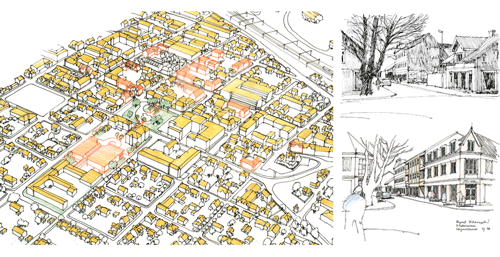
Figure 4.7 Infill opportunities in central parts of Sarpsborg, shown in red.
Source The municipality of Sarpsborg and Svein Jakobsen
4.2.7 Development patterns and transportation systems should be used actively to reduce energy consumption, greenhouse gas emissions and air pollution
Urban sprawl may contribute to increased local air pollution and greenhouse gas emissions. It results in unnecessary large land-use and energy consumption because of long distances and increased dependency on the private car — a polluting type of transport that demands land and energy. Also, urban sprawl makes it harder to implement alternative and efficient energy supplies for housing and businesses or commercial activity.
The development pattern and transportation system should be employed actively to reduce local air pollution, greenhouse gas emissions and energy consumption, by developing environmentally friendly urban organisation — by concentrating new development around nodes for public transport and in downtown areas. This will lead to short distances and increase walking, biking and public transport. Local neighbourhoods in cities and towns should be sheltered from through-traffic. The municipalities should exercise caution when deciding on the localisation of particularly sensitive activities (schools, kindergartens, etc), and avoid areas troubled by local air pollution.
The development pattern should, to the greatest possible extent, be adjusted to accommodate waterborne district-heating systems. In areas where energy supply systems like this might be feasible, buildings should be equipped with internal systems for waterborne heating systems. Also, built-up areas should be planned in order to reduce distances between the different points of connection to the energy source. This also increases the opportunities to hook up new development to the central heating system.
4.3 Protection and development of green structures
Continuous green structures, supplemented by separate green areas, represent one of the main elements of an environmentally friendly city or town structure. In large urban agglomerations protecting continuity in the green structure and water areas is as important as the regional development pattern or transportation system. The challenge of shielding the green structure for the benefit of the populace is particularly important in cities and bigger towns. Parliament has stressed that protection of green areas for children's play and development should constitute an important political principle when deciding on development patterns and transportation systems.
To avoid further downsizing of green areas, municipalities must safeguard a functional and continuous green structure that connects downtown areas, residential areas, schools and kindergartens. The green structure should assure the population access to areas along the coast, lakes, rivers and creeks, as well as cultivated farmland, other cultural environments and surrounding forests (like the proposal on green strategy for Trondheim, for example).
The green structure should ideally be varied and consist of different elements of nature to give diverse impressions, cover different needs of the inhabitants and contribute to protect biological diversity. Continuity in hiking routes should be secured, and safe crossing-infrastructure should be established where road traffic is heavy.
Fragmentation of the green structure should be avoided, by avoiding particularly the kindergartens, schools and sporting grounds that destroy continuity. Such projects, however, may benefit from being located next to green corridors and utilise the opportunities these present.
The development of an environmentally friendly transportation system should be viewed in the context of the green structure. Bicycle paths and walkways may be localised to green areas as an alternative to heavily trafficked roads as long as it doesn't result in longer routes and less efficient transport. In situations like this, the paths and trails must be developed in ways that don't negatively affect the qualities of the green areas.
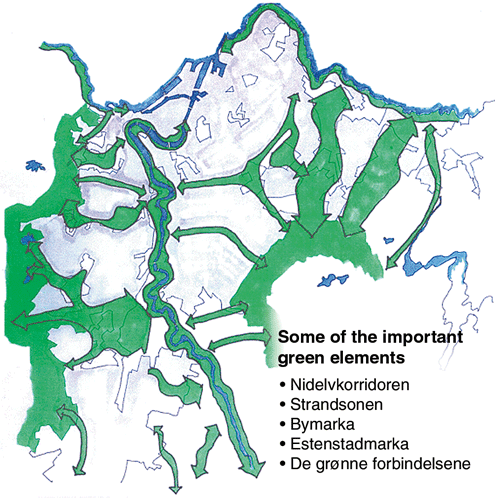
Figure 4.8 Proposed Masterplan for green-structure strategy for Trondheim.
Source The municipality of Trondheim, Hans-Jørgen Foss
The farmland regions surrounding many cities are attractive for outdoor activities. The hiking network in areas like this should be protected and developed as an important link between the green structures in the cities and the surrounding landscape. Agreements with property owners may be necessary to assure the permanent use of local corridors for travel.
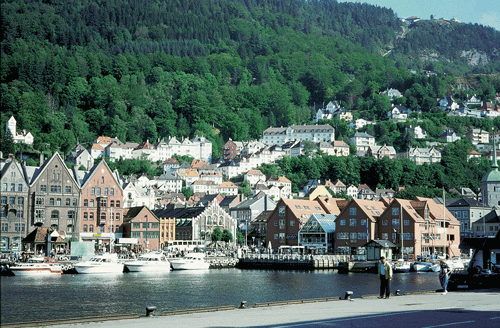
Figure 4.9 The main city inlet, Vågen, in Bergen shows the importance of blue (water) and green structures for urban form and identity.
Photo: Hogne Langset
Undeveloped nature areas around cities and towns should be protected and developed as attractive areas for outdoor activity. In the White Paper on Outdoor activity, all municipalities with city woodlands are expected to develop a boundary between developed and non-developed land, as well as a plan of management of natural areas, within the year of 2006. Also, the Planning and Building Act is going to be revised to better fit the need of safeguarding the interests of natural, cultural and outdoor environments. A planning and management guide is also going to be developed.
The Report No. 39 to the Storting (2001-2002) Outdoor activity advises mapping registration and value assessments of green structures in all municipalities with growing cities and towns within 2006. The green structure should be registered and integrated in plans for land-use, centre-structure and transportation. Protection of the green structure should be included in preventive, municipal health-care strategies. A number of municipalities have already committed resource to mapping, systematising and making accessible information on green areas, using the «Green Poster» and partial plans for green structure, among other methods. The county of Vestfold has developed a method for registering «Children's movements», which is now being used in several municipalities.
The challenge is to implement the green-structure plans, both to ensure continuity and safe infrastructure-crossings. Some municipalities lack capacity and competence. The Directorate for Nature Management will develop guidelines, in order to enhance and support the municipalities.
4.4 Protection of cultural milieus and historical city-structures
Historical structures in cities and towns must be protected. Main routes for transportation, networks of streets, parks, urban spaces, building patterns, shorelines, river outlets and other historical elements form the basis for further development. These have long been central development structures and they represent an important framework for future urban development of cities and towns. They help convey the history of cities and towns, they are valuable for recreation, and they shape meeting places essential for the cities' diversity and prosperity.
Within this structural framework there are buildings and other elements reflecting the needs, practical solutions and aesthetic ideals of different periods of time. Buildings are often closely built and can rather easily be adjusted to various functions in today's society. The density and environmental qualities should be utilised as a resource to develop attractive areas for housing, service and other activities. Infill and transformation of existing buildings may affect historical value negatively. Appropriate and feasible solutions for development require early considerations of historical and environmental qualities, in order to make the best use of assets and avoid potential conflicts.
Precious qualities for both the city and the local neighbourhood should be protected, both within the single areas for development and when improving selected buildings. This requires registering and conscious assessment at the level of strategic planning of quality in the existing city-structure, and at the physical and constructed surroundings. At this planning level, important criteria are established to decide which neighbourhoods are the most suitable for infill, which are suitable for transformation, and which areas should be developed based on current qualities and characteristics. These choices may become crucial when deciding on real actions to be taken and measures to be implemented. Several cities have satisfactorily registered their cultural heritage sites and milieus. When choosing which sites to prioritise, municipalities should base their decisions on such mapping and registration, in co-operation with regional cultural heritage authorities.
Archaeological artefacts of cultural heritage, in and beneath the soil, are the only sources of knowledge and insight into much of our 12,000-year history. Invading cultural layers — tearing down buildings, changing land-use in different ways — must occur in a way that safeguards historical structures in cities and protects cultural heritages.